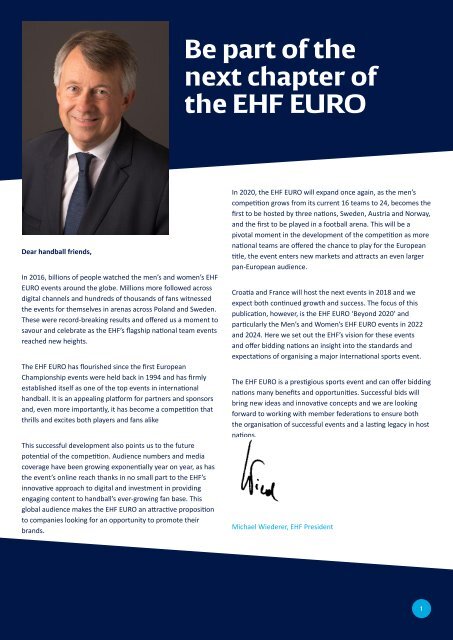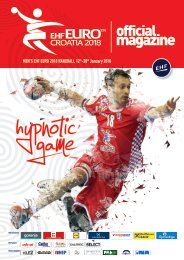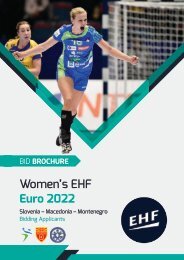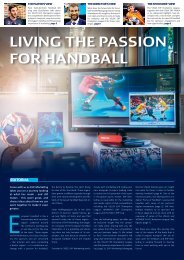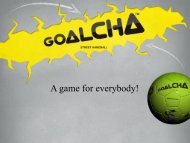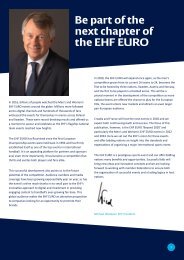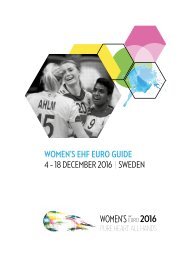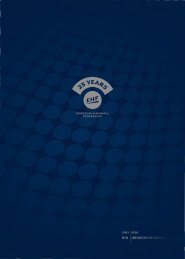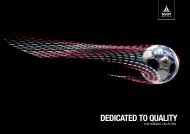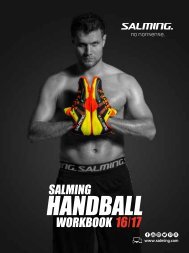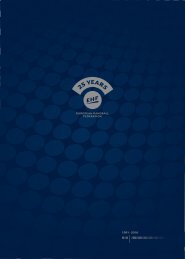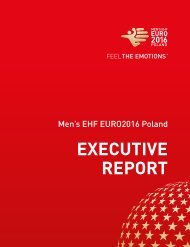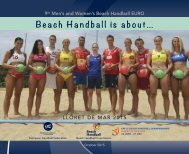Beyond 2020 Brochure-web
You also want an ePaper? Increase the reach of your titles
YUMPU automatically turns print PDFs into web optimized ePapers that Google loves.
Be part of the<br />
next chapter of<br />
the EHF EURO<br />
Dear handball friends,<br />
In 2016, billions of people watched the men’s and women’s EHF<br />
EURO events around the globe. Millions more followed across<br />
digital channels and hundreds of thousands of fans witnessed<br />
the events for themselves in arenas across Poland and Sweden.<br />
These were record-breaking results and offered us a moment to<br />
savour and celebrate as the EHF’s flagship national team events<br />
reached new heights.<br />
The EHF EURO has flourished since the first European<br />
Championship events were held back in 1994 and has firmly<br />
established itself as one of the top events in international<br />
handball. It is an appealing platform for partners and sponsors<br />
and, even more importantly, it has become a competition that<br />
thrills and excites both players and fans alike<br />
This successful development also points us to the future<br />
potential of the competition. Audience numbers and media<br />
coverage have been growing exponentially year on year, as has<br />
the event’s online reach thanks in no small part to the EHF’s<br />
innovative approach to digital and investment in providing<br />
engaging content to handball’s ever-growing fan base. This<br />
global audience makes the EHF EURO an attractive proposition<br />
to companies looking for an opportunity to promote their<br />
brands.<br />
In <strong>2020</strong>, the EHF EURO will expand once again, as the men’s<br />
competition grows from its current 16 teams to 24, becomes the<br />
first to be hosted by three nations, Sweden, Austria and Norway,<br />
and the first to be played in a football arena. This will be a<br />
pivotal moment in the development of the competition as more<br />
national teams are offered the chance to play for the European<br />
title, the event enters new markets and attracts an even larger<br />
pan-European audience.<br />
Croatia and France will host the next events in 2018 and we<br />
expect both continued growth and success. The focus of this<br />
publication, however, is the EHF EURO ‘<strong>Beyond</strong> <strong>2020</strong>’ and<br />
particularly the Men’s and Women’s EHF EURO events in 2022<br />
and 2024. Here we set out the EHF’s vision for these events<br />
and offer bidding nations an insight into the standards and<br />
expectations of organising a major international sports event.<br />
The EHF EURO is a prestigious sports event and can offer bidding<br />
nations many benefits and opportunities. Successful bids will<br />
bring new ideas and innovative concepts and we are looking<br />
forward to working with member federations to ensure both<br />
the organisation of successful events and a lasting legacy in host<br />
nations.<br />
Michael Wiederer, EHF President<br />
1
THE MOST EL ECTRIFYING TEAM SPORT IN EUROPE<br />
Europe’s N o .1<br />
indoor sport<br />
115<br />
MILLION<br />
HANDBALL<br />
FANS<br />
HUGE<br />
GLOBAL<br />
TV AUDIENCE<br />
1.5<br />
MILLION<br />
HANDBALL<br />
PLAYERS<br />
FAST-<br />
PACED<br />
DYNAMIC<br />
SPORT<br />
EHF EURO<br />
BEYOND <strong>2020</strong><br />
3
THE EHF EURO IN NUMBERS<br />
EHF EURO<br />
world’s most competitive<br />
24 EVENTS<br />
SINCE 1994<br />
NORWAY<br />
MOST SUCCESSFULL<br />
WOMEN’S SIDE<br />
handball tournament<br />
SWEDEN<br />
HAVE WON 4<br />
MEN’S GOLDS<br />
CROATIA<br />
FIRST NATION TO<br />
HOST MEN’S<br />
EHF EURO TWICE<br />
17<br />
NATIONS<br />
HAVE HOSTED<br />
THE EHF EURO<br />
The EHF EURO is the European Handball Federation’s flagship national team<br />
event. First played in 1994, the final tournaments for men and women have<br />
established themselves over the past two-and-a-half decades as leading events<br />
on the international sports market.<br />
Each event is followed by billions around the globe on TV, across digital<br />
platforms and also live in sold-out arenas in each host nation. The competition<br />
brings together Europe’s top teams and the world’s best players in a format<br />
that is both interesting and enthralling not only to fans and players but also<br />
the media, partners and sponsors.<br />
EHF EURO’S TV AUDIENCE<br />
KEEPS GROWING<br />
1.6 Billion TV viewers for Poland 2016<br />
4930<br />
1569<br />
1610<br />
643<br />
1366 380<br />
Combined<br />
1224<br />
Total<br />
1094<br />
352<br />
335<br />
Women<br />
748<br />
723<br />
461<br />
385<br />
Men<br />
340 328<br />
157<br />
96 100<br />
156<br />
53 53 97<br />
43 47 60 184 420 709 763 1217 1031 1472 887 1652<br />
1994 1996 1998 2000 2002 2004 2006 2008 2010 2012 2014<br />
EHF EURO<br />
BEYOND <strong>2020</strong><br />
YEAR<br />
Media Performance of EHF EURO<br />
TV audience (millions) 1994-2016<br />
1852<br />
2295<br />
2016<br />
3059<br />
2672<br />
1919<br />
2006<br />
1161<br />
Combined<br />
1259<br />
966<br />
Total<br />
962<br />
884<br />
Men<br />
552<br />
824<br />
398<br />
Women<br />
763<br />
405<br />
354<br />
233 295<br />
296<br />
110 145<br />
186<br />
123 150 219 467 470 564 707 1122 1706 1898 2333 2958<br />
1994 1996 1998 2000 2002 2004 2006 2008 2010 2012 2014<br />
YEAR<br />
Media Performance of EHF EURO<br />
Hours of programming 1994-2016<br />
4252<br />
1972<br />
2016<br />
75
THE MOST<br />
SUCCESSFUL<br />
EHF EURO YET<br />
1 billion impressions on official<br />
hashtag #ehfeuro2016<br />
400,622<br />
RECORD N O. OF<br />
SPECTATORS<br />
60 MILLION<br />
DIGITAL REACH<br />
1 MILLION<br />
UNIQUE USERS<br />
EHF-EURO.COM<br />
The Men’s EHF EURO 2016 in Poland was the biggest and best EHF EURO to<br />
date. The Polish Handball Federation invested a considerable amount into<br />
the event, not just in financial terms but also human resources and passion<br />
to create an event that was followed by the biggest TV audience yet. Millions<br />
followed across digital channels too, with a 300% increase in digital reach<br />
compared to the previous EHF EURO in 2014 in Denmark.<br />
There was a real handball fever in sport-loving Poland in January 2016 as fans<br />
packed into the arenas in the host cities in Krakow, Katowice, Wroclaw and<br />
Gdansk during the two weeks of the championship. A record 400,622 fans<br />
watched the 48 matches of the tournament live in the arenas, breaking the<br />
previous total of 316,500 set in Denmark in 2014. The handball party also<br />
extended into the centre of each of the cities where fans without tickets were<br />
able to follow the action live via public viewing and join in the party in special<br />
fan zones created for the event.<br />
1.65<br />
BILLION<br />
TV AUDIENCE<br />
BROADCAST<br />
IN 175<br />
TERRITORIES<br />
2,958<br />
HOURS<br />
OF COVERAGE<br />
MOST WATCHED EHF EURO EVER<br />
EHF EURO<br />
BEYOND <strong>2020</strong><br />
7
Men’s EHF EURO 2018<br />
Women’s EHF EURO 2018<br />
WHERE NEXT<br />
for the EHF EURO<br />
Varaždin<br />
(Group D)<br />
CROATIA<br />
The next Men’s EHF EURO will take place in Croatia<br />
in January 2018. It marks a significant point in the<br />
history of the competition. The 13th edition of the<br />
Men’s EHF EURO will be the first to be hosted by a<br />
nation for the second time (Croatia hosted back in<br />
2000) and also the final men’s event to be played with<br />
16 teams.<br />
The event will be played from 12 to 28 January 2018<br />
with Europe’s top teams competing in the preliminary<br />
round in Split (Group A), Poreć (Group B), Zagreb<br />
(Group C) and Varaždin (Group D). The three best<br />
ranked teams from the preliminary round will move to<br />
main round in Varazdin and Zagreb. The final weekend<br />
will be played in Arena Zagreb in front of over 15,000<br />
spectators.<br />
The Croatian Handball Federation is working hard<br />
to ensure full arenas in January 2018 through<br />
promotional activities focused around its mascot, Tor.<br />
Using the hashtag #TorOnTour the mascot has been<br />
travelling around Europe to raise the profile of the<br />
final tournament.<br />
FRANCE<br />
France will host an EHF EURO event for the first time<br />
in its history in December 2018. The event will be played from 29<br />
November to 16 December 2018, an additional day added to the<br />
programme to allow for the playing of an opening match involving the<br />
French national side.<br />
Five different venues around the country will host the 16 participating<br />
teams. The preliminary round will be played in Nantes, Brest,<br />
Montbéliard and Nancy, the main round in Nantes and Nancy before<br />
the event moves to the nation’s capital, Paris, for the final weekend.<br />
The event’s slogan is ‘Handballissme’, a simple yet powerful message<br />
encouraging all towards maximum achievement in 2018.<br />
After having entertained more than 540,000 people during the Men’s<br />
World Handball Championship in 2017, the tournament’s much-loved<br />
mascots, Rok and Koolette, have been brought back to promote the<br />
Women’s EHF EURO 2018. The two characters embody the values<br />
of handball, combining strength and power for Rok, agility and<br />
dynamism for Koolette, their names referring to the “roucoulette”,<br />
the French word for spin shot.<br />
Brest<br />
Nantes<br />
Paris<br />
(Final weekend)<br />
France<br />
Nancy<br />
Montbéliard<br />
OFFICIAL<br />
MATCH<br />
BALL<br />
Zagreb<br />
(Group C)<br />
Croatia<br />
Poreć<br />
(Group B)<br />
TOURNAMENT GROUP DRAW RESULT<br />
Group A<br />
Croatia<br />
Sweden<br />
Serbia<br />
Iceland<br />
Group B<br />
France<br />
Belarus<br />
Norway<br />
Austria<br />
Group C<br />
Germany<br />
FYR Macedonia<br />
Montenegro<br />
Slovenia<br />
Split<br />
(Group A)<br />
Group D<br />
Spain<br />
Denmark<br />
Czech Republic<br />
Hungary<br />
ROK AND<br />
KOOLETTE<br />
RETURN<br />
9
Men’s EHF EURO <strong>2020</strong><br />
Women’s EHF EURO <strong>2020</strong><br />
Sweden, Austria & Norway<br />
In <strong>2020</strong>, the Men’s EHF EURO will take a giant step forward as<br />
it expands from a 16-team event to be played with 24 teams.<br />
Also, another first will see the event hosted by three nations.<br />
First to take up the challenge are the federations of Sweden,<br />
Austria and Norway; three hosts with a wealth of experience,<br />
having organised six men’s and women’s events between<br />
them. Norway will also co-host the women’s event in <strong>2020</strong>.<br />
FIRST<br />
EHF EURO<br />
WITH 24<br />
TEAMS<br />
Trondheim<br />
Norway<br />
Malmő<br />
Gothenburg<br />
RECORD CROWD<br />
FOR FINALS PLANNED<br />
Sweden<br />
Stockholm<br />
(Finals)<br />
Austria<br />
Graz<br />
Vienna<br />
The three organisers plan to hold the championship in six<br />
different cities and venues have confirmed that this EHF<br />
EURO will be the first to be played in a football arena, with<br />
the final weekend to be held in Stockholm’s Tele 2 Arena,<br />
a multi-purpose stadium with a retractable roof in front<br />
of 24,000 specatators. The six preliminary round groups<br />
shall be played in the Austrian cities of Vienna and Graz,<br />
the Norwegian city of Trondheim and the Swedish cities of<br />
Malmö and Gothenburg. The main round will take place in<br />
Vienna and Sweden (either Malmö or Gothenburg), and for<br />
the finals the tournament will move to the Swedish capital<br />
Stockholm.<br />
10 X<br />
WINNERS<br />
NORWAY &<br />
DENMARK<br />
Stavanger<br />
Trondheim<br />
Herning<br />
NORWAY & DENMARK<br />
Norway<br />
Oslo<br />
(Finals)<br />
Denmark<br />
Two of the most successful women’s handball nations of all time will join forces in<br />
<strong>2020</strong> to host the 14th edition of the final event after being awarded the event at<br />
the EHF Congress in Dublin in September 2014.<br />
Together they have won a total of 10 EHF EURO titles and also rank amongst the<br />
most experienced host nations in Europe. They were joint hosts of the women’s<br />
event in 2010; Denmark hosted the women’s event in 1996 and 2002 and the<br />
men’s in 2014. Norway previously hosted the men’s event in 2008 and will also<br />
co-host with Sweden and Austria in <strong>2020</strong>. The event is scheduled to be played 4<br />
to 20 December <strong>2020</strong>.<br />
Venues<br />
Norway will take the lead in the organisation of the event with the final round<br />
set to be played in the Telenor Arena in the capital, Oslo. The preliminary round<br />
will be played in the 14,000-capacity Boxen Arena in Herning, Denmark and<br />
Trondheim, Norway. The main round will take place in Herning and Stavanger’s<br />
Idrettshall.<br />
EHF EURO<br />
BEYOND <strong>2020</strong><br />
11
EVENT<br />
CONCEPT<br />
EHF EURO 2022 /24<br />
MATCH SCHEDULE<br />
WOMEN’S EHF EURO 2018<br />
16 TEAMS DIVIDED INTO 4 GROUPS<br />
A1 / A3<br />
A2 / A4<br />
PRELIMINARY ROUND - 4 GROUPS<br />
The first three teams from each group are qualified for the main round<br />
GROUP A NANTES PARC DES EXPOSITIONS - HALL XXL<br />
A4 / A1<br />
A3 / A2<br />
A3 / A4<br />
A1 / A2<br />
GROUP B NANCY PALAIS DES SPORTS JEAN WEILLE<br />
MAIN ROUND - 2 GROUPS<br />
The first two teams of each group are qualified for the semi-finals. The third of each group plays a match for 5th place<br />
3.A / 2.B<br />
2.A / 3.B<br />
2.A / 2.B<br />
BREST • MONTBÉLIARD • NANCY • NANTES • PARIS<br />
FINALS<br />
Monday Tuesday Wednesday<br />
Tuesday Wednesday Thursday Friday Friday<br />
Thursday Friday Saturday Sunday Monday Saturday Sunday Sunday<br />
GROUP I NANTES PARC DES EXPOSITIONS - HALL XXL<br />
1.A / 1.B<br />
3.A / 1.B<br />
1.A / 3.B<br />
3.A / 3.B<br />
2.A / 1.B<br />
1.A / 2.B<br />
PARIS ACCORHOTELS ARENA<br />
PLACE 5 - 6 PLACE 3 - 4<br />
3 .I / 3. II<br />
SEMI FINAL<br />
1. I / 2 .II<br />
/<br />
FINAL<br />
/<br />
B1/ B3 B2 / B4<br />
B4 / B1<br />
B3 / B4<br />
GROUP II NANCY PALAIS DES SPORTS JEAN WEILLE<br />
2 .I / 1. II<br />
3 RD PLACE<br />
B3 / B2<br />
B1/ B2<br />
3.C / 2.D<br />
2.C / 2.D<br />
3.C / 1.D<br />
3.C / 3.D<br />
L / L<br />
FINAL<br />
GROUP C BREST ARENA<br />
2.C / 3.D<br />
1.C / 1.D<br />
1.C / 3.D<br />
2.C / 1.D<br />
W /W<br />
C1 / C3<br />
C4 / C1<br />
C3 / C4<br />
1.C / 2.D<br />
With the Men’s and Women’s EHF EURO events in 2022 and 2024,<br />
a new era begins for the EHF’s flagship national team events. In <strong>2020</strong>, the<br />
Men’s EHF EURO will be played with 24 teams for the first time, the first truly<br />
pan-European championship and a massive development for the competition<br />
as it enters new markets and provides and provide more nations with the<br />
opportunity to play with the very best on the European stage.<br />
The event has already established itself in the psyche of the sports fan. Billions<br />
tune into the watch the men’s and women’s events, millions more following<br />
on digital channels and hundreds of thousands watch live for themselves in<br />
arenas. There are huge rewards for the organisers of the EHF EURO events in<br />
terms of the legacy a successful event can leave behind for the sport for many<br />
years to come.<br />
C2 / C4<br />
D1 / D3<br />
D2 / D4<br />
MATCH SCHEDULE<br />
MEN’S EHF EURO <strong>2020</strong><br />
24 TEAMS DIVIDED INTO 6 GROUPS<br />
PRELIMINARY ROUND - 6 GROUPS<br />
The first three teams from each group are qualified for the main round<br />
GROUP A<br />
GROUP A<br />
C3 / C2<br />
GROUP D MONTBELIARD L’AXONE<br />
D4 / D1<br />
D3 / D2<br />
C1 / C2<br />
D3 / D4<br />
D1 / D2<br />
16 MATCH DAYS*, 47 MATCHES<br />
*Extra match day to be played due to addition of an opening match<br />
The schedule is subject to change<br />
VIENNA • GRAZ • TRONDHEIM • MALMO • GOTHENBURG • STOCKHOLM<br />
MAIN ROUND - 2 GROUPS<br />
The first two teams of each group are qualified for the semi-finals. The third of each group plays a match for 5th place<br />
GROUP I<br />
FINALS<br />
Monday Tuesday Wednesday<br />
Wednesday Thursday Friday Friday<br />
Friday Saturday Sunday Monday Tuesday Saturday Sunday Sunday<br />
MEN’S EHF EURO 2022<br />
14 - 30 January<br />
WOMEN’S EHF EURO 2022<br />
4 - 20 November<br />
MEN’S EHF EURO 2024<br />
12 - 28 January<br />
WOMEN’S EHF EURO 2024<br />
29 November - 15 December<br />
The men’s and women’s events in 2022 and 2024 will be played in two<br />
different formats. 16 teams will play in the Women’s EHF EURO over 15 days.<br />
The preliminary round is made up of four teams each. The top three teams<br />
progress to the main round. The two top teams in each group then play in<br />
the semi-finals. An expanded men’s competition from <strong>2020</strong> sees 24 teams<br />
competing but still over 15 days. The major difference will be the fact that<br />
the preliminary round is played in six groups of four teams (examples on next<br />
page).<br />
An EHF EURO is, however, about more than just playing handball. It is a<br />
major international sports event and a brand in its own right. It needs to be<br />
promoted and fans want to be entertained. It is a communications platform<br />
for partners and sponsors and the needs of the media need to be catered for<br />
to ensure extensive worldwide coverage. Over the next few pages you will find<br />
out more about what it takes to organise the EHF EURO in 2022/24.<br />
A1 / A3<br />
A2 / A4<br />
A4 / A1<br />
A3 / A2<br />
GROUP B<br />
B1 / B3 B4 / B1<br />
B2 / B4<br />
B3 / B2<br />
GROUP C<br />
C1 / C3<br />
C4 / C1<br />
C2 / C4<br />
C3 / C2<br />
GROUP D<br />
D1 / D3<br />
D4 / D1<br />
D2 / D4<br />
D3 / D2<br />
GROUP E<br />
E1 / E3<br />
E4 / E1<br />
E2 / E4<br />
E3 / E2<br />
GROUP F<br />
F1 / F3<br />
F4 / F1<br />
F2 / F4<br />
F3 / F2<br />
A3 / A4<br />
A1 / A2<br />
B3 / B4<br />
B1 / B2<br />
C3 / C4<br />
C1 / C2<br />
D3 / D4<br />
D1 / D2<br />
E3 / E4<br />
E1 / E2<br />
F3 / F4<br />
F1 / F2<br />
1.C 3A / 2B 2.B<br />
2.A / 2.C<br />
1.C / 1.B<br />
1.A / 2.C<br />
1.A / 1.B<br />
2.A / 2.B<br />
GROUP II<br />
1.F / 2.E<br />
1.F / 1.E<br />
2.D / 2.F<br />
1.D / 2.F<br />
1.D / 1.E<br />
2.D / 2.E<br />
15 PLAYING DAYS, 65 MATCHES<br />
The schedule is subject to change<br />
1.A / 2.B<br />
2.A / 1.C<br />
1.B/ 2.C<br />
1.D / 2.E<br />
2.D / 1.F<br />
1.E / 2.F<br />
1.A / 1.C<br />
2.A / 1.B<br />
2.B / 2.C<br />
1.D / 1.F<br />
2.D / 1.F<br />
2.E / 2.F<br />
PLACE 5 - 6<br />
3 .I / 3 .II<br />
SEMI FINAL<br />
1. I / 2. II<br />
2 .I / 1. II<br />
3 RD PLACE<br />
L / L<br />
FINAL<br />
W /W<br />
EHF EURO<br />
BEYOND <strong>2020</strong><br />
13
EHF EURO ROUTE Qualification TO QUALIFICATION in the Future<br />
NEW FORMAT<br />
24 teams<br />
10/2016<br />
EHF EURO 2018<br />
EURO Qualification (1/2)<br />
EHF EURO <strong>2020</strong><br />
EURO Q phase 1 (1/2)<br />
from <strong>2020</strong><br />
01/2017<br />
EHF EURO <strong>2020</strong><br />
EURO Q phase 1 (3-6)<br />
04/2017<br />
EHF EURO 2018<br />
EURO Qualification (3/4)<br />
06/2017<br />
EHF EURO 2018<br />
EURO Qualification (5/6)<br />
7 Groups of 4 teams:<br />
1 st , 2 nd , and 1 best 3 rd<br />
ranked team qualifies<br />
EHF EURO <strong>2020</strong><br />
European IHF Trophy<br />
Winners qualify<br />
01/2018<br />
EHF EURO 2018 CRO<br />
16<br />
Eight additional nations will get the<br />
opportunity to play in the Men’s EHF EURO from <strong>2020</strong><br />
thanks to the expansion of the competition to 24 teams. The initiative from national<br />
federations will give a major boost to the ‘middle-ranked’ nations, which will now also have<br />
a realistic chance of playing at the top level and allow them to access additional funds and<br />
subsidies.<br />
This expansion also opens up new commercial opportunities for the competition as it<br />
enters new markets, opening up new and additional revenue streams through the sale of<br />
media and marketing rights as well as offering potential partners and sponsors a truly pan-<br />
European platform for the promotion of their brands.<br />
10/2018<br />
01/2019<br />
Winner qualifies<br />
EHF EURO <strong>2020</strong><br />
EURO Qualification (1/2)<br />
3 top ranked teams qualify<br />
EHF EURO 2022<br />
EURO Q phase 1 (1/2)<br />
EHF EURO 2022<br />
EURO Q phase 1 (3-6)<br />
EHF EURO<br />
BEYOND <strong>2020</strong><br />
With the objective of the first EHF EURO in <strong>2020</strong> with 24 teams in sight, the European<br />
Handball Federation developed various new initiatives to tackle the issue of qualification<br />
for the revamped EHF EURO. The changes started with the introduction of a new two-tier<br />
playing system from 2016 in the younger age category events, to encourage more nations to<br />
play in national team competitions.<br />
To maximise the number of nations playing in qualification, and aware that playing in<br />
qualification on a home and away basis can be challenging for many of the continent’s<br />
emerging nations, the EHF also integrated the Men’s IHF Emerging Nations Championship<br />
into the qualification system. For qualification to <strong>2020</strong>, no fewer than 48 out of the EHF’s 50<br />
member nations entered, with nine nations playing in the first phase of qualification and 15<br />
playing in the Men’s IHF Emerging Nations Championship.<br />
04/2019<br />
06/2019<br />
01/<strong>2020</strong><br />
24<br />
EHF EURO <strong>2020</strong><br />
EURO Qualification (3/4)<br />
EHF EURO <strong>2020</strong><br />
EURO Qualification (5/6)<br />
8 Groups of 4 teams:<br />
1 st 2 nd and best 3 rd<br />
ranked teams qualify<br />
EHF EURO <strong>2020</strong><br />
SWE/AUT/NOR<br />
EHF EURO 2022<br />
European IHF Trophy<br />
Qualified teams tbd<br />
EHF EURO 2022<br />
Qualification Groups<br />
15
IDENTITY<br />
the EHF EURO<br />
logo evolves<br />
In 2016 a new corporate identity was launched for the<br />
EHF EURO events, starting with the Men’s EHF EURO<br />
<strong>2020</strong>. For over 20 years the EHF EURO logo has changed<br />
with each championship, often causing problems<br />
in its implementation in areas such as TV graphics,<br />
merchandising and printing.<br />
The further development of the EHF EURO brand was<br />
clear for all to see from the start of the Men’s EHF<br />
EURO 2016 in Poland. Gone was the distinctive but<br />
outdated ‘yellow and blue’ flooring system that was<br />
first introduced in 1998 to be replaced by a lagoon<br />
floor, already well known to handball fans given that it<br />
has been an integral part of the EHF Champions League<br />
brand since 2006. Extra elements, however, make the<br />
floor unique to the EHF EURO. The area surrounding<br />
the court is dark blue as is each six-metre area – the<br />
same blue as used in the updated EHF logo – and, a key<br />
feature of the previous floor, the coaching zone, is red.<br />
5 COLOURS<br />
5.1 COLOUR PALETTE<br />
The MEN’S EHF EURO <strong>2020</strong> colour palette<br />
consists of pre-defined complementary<br />
colours to give maximum flexibility in their<br />
use.<br />
It may occur that for applications of the<br />
logo on/in textiles, the colours of the<br />
MEN’S EHF EURO <strong>2020</strong> palette are not<br />
available; in this case the closest possible<br />
colours need to be selected; colours that<br />
fall out of the MEN’S EHF EURO <strong>2020</strong>.<br />
CMYK RGB<br />
Pantone<br />
Black White<br />
Monochromatic<br />
Hexadecimal_Web<br />
Process colour values RGB colour values Pantone colour values Process colour values Process colour values Process colour values Hex. colour values<br />
7<br />
REPRODUCTION<br />
PROCESS CARD<br />
CMYK<br />
Tonal = 1<br />
Flat = 2<br />
This page gives you a quick overview of which logo state to supply<br />
when you are producing your communication material.<br />
RGB<br />
Pantone<br />
Black<br />
White<br />
Monochromatic Hexadecimal_Web<br />
Flat = 3 Flat = 4 5 6<br />
Flat = 7<br />
Flat = 8<br />
Printing<br />
Four-colour/digital 1<br />
Two-colour 2 4 5 6<br />
One-colour 5 6 7<br />
Silk-screen 5 6<br />
1 4<br />
On-screen<br />
Electronic media 3<br />
Word processing 3 5 7<br />
Web 3 8<br />
The new EHF EURO corporate identity incorporates a<br />
design system, which reflects not only the EHF brand<br />
but also the individual characteristics and flare of each<br />
championship. The EHF logo is at the centre of the new<br />
logo and each organiser has the freedom to create an<br />
individual logo for their event within the framework of<br />
the design system.<br />
The aim of the changes is to create a consistent look<br />
for handball in Europe - with the use of the distinctive<br />
‘lagoon blue’ already used in the EHF Champions<br />
League - that handball fans will recognise as being a<br />
common feature across all EHF’s top competitions. The<br />
floor has also been introduced to the EHF’s top younger<br />
age category events.<br />
1<br />
100/54/4/19<br />
1<br />
0/82/147<br />
1<br />
PMS 301 C<br />
1 1 1<br />
0/0/0/100 0/0/0/0 0/0/0/77<br />
1<br />
#005293<br />
Television 3<br />
2<br />
3<br />
4<br />
5<br />
6<br />
7<br />
8<br />
9<br />
0/14/100/0<br />
0/86/63/0<br />
0/0/0/0<br />
11/100/85/2<br />
0/0/0/0<br />
100/68/21/5<br />
0/0/0/10<br />
100/70/0/72<br />
2<br />
3<br />
4<br />
5<br />
6<br />
7<br />
8<br />
9<br />
254/203/0<br />
239/51/64<br />
255/255/255<br />
210/16/52<br />
255/255/255<br />
0/85/155<br />
238/239/239<br />
0/20/50<br />
2<br />
3<br />
4<br />
5<br />
6<br />
7<br />
8<br />
9<br />
PMS 116 C<br />
PMS 032 C<br />
PMS 186 C<br />
PMS 287 C<br />
PMS Cool Gray 1 C<br />
PMS 648 C<br />
EHF MEN’S EURO <strong>2020</strong> // BRAND IDENTITY & LOGO USAGE GUIDE LINES // PAGE 21<br />
2<br />
3<br />
4<br />
5<br />
6<br />
7<br />
8<br />
9<br />
0/0/0/20<br />
0/0/0/55<br />
0/0/0/0<br />
0/0/0/70<br />
0/0/0/0<br />
0/0/0/82<br />
0/0/0/10<br />
0/0/0/100<br />
2<br />
3<br />
4<br />
5<br />
6<br />
7<br />
8<br />
9<br />
#FECB00<br />
#EF3340<br />
#FFFFFF<br />
#B51B33<br />
#FFFFFF<br />
#2D518D<br />
#EEEFEF<br />
#041145<br />
Other<br />
Embroidery 2 5 6 7<br />
Embossing/debossing 5<br />
Etching/engraving 5<br />
Holography 5<br />
To guarantee quality reproduction, do supply .ai or .eps files or highly defined .jpg (.jpeg) files.<br />
EHF MEN’S EURO <strong>2020</strong> // BRAND IDENTITY & LOGO USAGE GUIDE LINES // PAGE 24<br />
The first version of the logo for <strong>2020</strong> combines the<br />
colours of the three host nations in the same space<br />
while incorporating each country’s flag. Combined with<br />
the EHF logo and its official font, the logo the logo offers<br />
a clear and uncomplicated design, but still allows for<br />
creativity to flourish and partnerships to evolve.<br />
EHF EURO<br />
BEYOND <strong>2020</strong><br />
The system does also allow for some flexibility. The<br />
newest addition to the logo family is the composite<br />
logo so that every official sponsor, host city, partner or<br />
supplier can have their brand implemented in the right<br />
way.<br />
17
ORGANISATION<br />
of the EHF EURO<br />
The organisation of an international sports event such the EHF EURO is a major<br />
undertaking for any national federation and many different aspects have to<br />
be taken into consideration right from the awarding of the event by the EHF<br />
Congress.<br />
A basic timeline is defined for organisers for the next four to six year period<br />
detailing all the preparation and tasks that need to be completed before<br />
the final tournament. Continual expert assistance and support is provided<br />
throughout the process by the EHF and its event partners with regular<br />
workshops and site visits to ensure progress towards the final event.<br />
Key elements such as venues, ticketing and preparation events have to be<br />
agreed with the EHF as do aspects such as event promotion, the organisation<br />
of draw events, heads of delegation conference and the officials conference.<br />
Underpinning the organisation of the event is a professional team of staff and<br />
volunteers, especially in key areas such as media management, marketing,<br />
finances, venue management, logistics, transport and ticketing.<br />
Men’s EHF EURO:<br />
100 Staff, 1,800 Volunteers,<br />
EHF EURO<br />
6 arenas, more than 500,000 fans<br />
BEYOND <strong>2020</strong><br />
Women’s EHF EURO:<br />
70 Staff, 1,200 Volunteers,<br />
4 arenas, more than 400,000 fans<br />
17 19
Clear & Exclusive Partner Structure<br />
PARTNERS<br />
& SPONSORS<br />
The EHF EURO provides partners and sponsors with<br />
an unrivalled pan-European platform through which to promote and<br />
activate their brands and products to an audience of billions on TV as well as<br />
through digital channels and on-site.<br />
The package of benefits available to the event’s official sponsors includes:<br />
strong brand positioning in camera view around the court through advertising<br />
sequences on LED boards, floor stickers and interview backdrops as well as full<br />
activation rights, corporate hospitality opportunities and tickets. From the EHF<br />
EURO 2018 in Croatia, sponsors will be able to make use of a full 80 metres of<br />
LED advertising surrounding the court, providing much improved visibility for<br />
brands and their advertising.<br />
In addition to presence in the arenas, sponsors can also benefit from many<br />
additional branding and activation opportunities. Through branded content<br />
or campaigns on digital channels, it is possible to engage with millions of<br />
fans through the EHF EURO events’ official digital channels. On-site too,<br />
opportunities can be provided for activation at special locations in the host<br />
cities, including fan areas in the city centres or arenas.<br />
TITLE<br />
SPONSOR<br />
• Most exclusive level in the<br />
partner hierarchy<br />
• Complete category exclusivity<br />
• All available rights<br />
8 OFFICIAL<br />
SPONSORS<br />
ADVERTISING<br />
PARTNERS<br />
EHF PARTNERS<br />
EHF EURO<br />
BEYOND <strong>2020</strong><br />
8 NATIONAL SUPPLIERS<br />
21
PROMOTION<br />
of the EHF EURO<br />
CASE STUDY:<br />
Men’s EHF EURO 2010<br />
The Austrian Handball Federation had to work hard to create ‘Magic Moments’<br />
in Austria in 2010 but thanks to an extensive international promotions tour<br />
and a little help from DJ Ötzi’s extremely catchy song ‘Sweet Caroline’ the<br />
event proved to be one of the most memorable EHF EUROs to date.<br />
Visit beyond<strong>2020</strong>.ehfoffice.at to read the complete case study<br />
Every EHF EURO organiser dreams of sold-out arenas, record TV<br />
audiences and the chance to raise the profile of handball in their home nation<br />
through the successful organisation of this high profile international event.<br />
This success, however, comes only with careful planning and a lot of hard work<br />
in the run-up to the event to publicise and promote both on a national and<br />
international basis to raise awareness of the organisation of the event and sell<br />
tickets.<br />
CASE STUDY<br />
Men’s EHF EURO 2016<br />
The Polish Handball Federation’s promotion of EHF EURO 2016 started a full<br />
20 months before the event threw off in the country. With a whole series of<br />
promotional events in Poland, across Europe and worldwide aimed at selling<br />
tickets and, indirectly, popularising handball in the country.<br />
Visit beyond<strong>2020</strong>.ehfoffice.at to read the complete case study<br />
A carefully thought-out and targeted promotional plan forms an essential<br />
part of the organisation of any major event to raise the profile of the event to<br />
handball fans looking to buy tickets and also to create a buzz around the event<br />
once the matches begin. The most successful EHF EURO events to date have<br />
been highly active in their promotional campaigns through social and digital<br />
media channels, special media events, PR events, an official song as well as<br />
mascot and trophy tours.<br />
EHF EURO<br />
BEYOND <strong>2020</strong><br />
To read more visit the complete<br />
case studies at beyond<strong>2020</strong>.ehfoffice.at<br />
23
EVENT<br />
EXPERIENCE<br />
Top-class handball has long been about more than simply two<br />
teams competing over 60 minutes.<br />
The handball match has become an event and the sport a form of<br />
entertainment, competing to attract fans not just from other sports but also<br />
many other leisure activities – and it is a competitive market.<br />
Fans want an experience well beyond the handball court and their<br />
expectations have been raised by the development of major sports events, like<br />
the VELUX EHF FINAL4, where the sporting action is mixed with spectacular<br />
show elements.<br />
Partners and sponsors too want more than simple brand exposure through<br />
television or in the arena through floor or LED advertising systems. They want<br />
to create a dialogue with fans and their customers and to engage with them<br />
whether this be on site through promotional stands or corporate hospitality or<br />
through social and digital campaigns.<br />
At the EHF EURO events, the overall event experience is key to attracting<br />
fans to the event and ensuring that they come back for more. This is a major<br />
consideration for organisers and includes entertainment, VIP and corporate<br />
hospitality opportunities, fan zones and promotional areas as well as<br />
entertainment, music and show elements around matches.<br />
EHF EURO<br />
BEYOND <strong>2020</strong><br />
25
Engaging the mobile generation<br />
1BILLION<br />
IMPRESSIONS<br />
#ehfeuro2016<br />
DIGITAL<br />
ENGAGEMENT<br />
EHF’s digital channels have increased their reach by more than 300 per cent<br />
The challenge for the EHF has been how it can best create media-rich content for a variety of channels to<br />
engage effectively with its growing mobile audience. The answer: mobile journalism, and a team of reporters<br />
providing innovative behind-the scenes coverage using just their mobile devices and a variety of apps.<br />
At the Men’s EHF EURO 2016 in Poland, a team of eight mobile journalists joined the EHF’s media team. This<br />
record-breaking event saw the EHF’s digital channels grow their reach by more than 300 per cent, engaging an<br />
audience of upwards of 60 million thanks in no small part to the extensive behind-the-scenes content gathered<br />
by mobile reporters.<br />
With the Men’s EHF EURO 2014 in Denmark came the<br />
development of a new digital strategy for the EHF EURO events.<br />
The official <strong>web</strong>site, ehf-euro.com, was relaunched, new social<br />
media channels were added and there was a fresh approach<br />
to content creation, with a focus on the development of<br />
storytelling and engaging multi-media content. A team of almost<br />
30 media professionals now provides content for the official EHF<br />
EURO channels during each event.<br />
The EHF has also pioneered the use of mobile journalism in its<br />
coverage. As the smartphone has become the defining device<br />
when it comes to news consumption, mobile journalism has<br />
enabled the federation to engage quickly and effectively with its<br />
continuously growing fan base.<br />
Over the course of the 2016/17 season, mobile reporters have regularly covered club competitions including<br />
the VELUX EHF FINAL4 and Women’s EHF FINAL4 and also all of beach handball’s final tournaments. 2016<br />
ended with the Women’s EHF EURO 2016 in Sweden, and the coverage provided by the EHF’s mobile reporters<br />
over the course of the 15-day event proved that within the span of less than 12 months the EHF’s mobile<br />
journalism strategy had taken the next step forward.<br />
A dedicated Snapchat mobile reporter was also added to the team for the first time at the<br />
Women’s EHF EURO, bringing a new level of personality, creativity and originality<br />
to the coverage, unleashing the potential of Snapchat as a captivating<br />
storytelling tool in particular for younger audiences. This has also led to<br />
the development of a brand new format for the platform with the first<br />
‘Handball Zap’, a magazine format show.<br />
At the Men’s EHF EURO 2016 in Poland in January, mobile and<br />
tablet usage accounted for 54 per cent of visits to the official<br />
<strong>web</strong>site, www.ehf-euro.com. For the first time, mobile use had<br />
exceeded visits from desktops. Figures for the Women’s EHF<br />
EURO 2016, played in December across Sweden, showed that<br />
60 per cent of all users accessed the <strong>web</strong>site with a mobile<br />
device. Furthermore, the EHF’s social media channels on Twitter,<br />
Facebook, Instagram and Snapchat – channels which are aimed<br />
primarily at mobile users – have accumulated a following of<br />
more than 500,000 people.<br />
EHF EURO<br />
BEYOND <strong>2020</strong><br />
27
MEDIA & TV<br />
ensuring the whole world<br />
sees the EHF EURO<br />
The EHF prides itself on its positive relationship with the<br />
sport’s media and seeks to provide the best working conditions to ensure<br />
both positive and extensive coverage of the EHF EURO events worldwide.<br />
This is particularly important at the EHF EURO events, where more than 1,000<br />
media representatives can be on-site, and a close cooperation is essential<br />
between the EHF’s own media team, the organising committee and media<br />
partners.<br />
1.65<br />
BILLION<br />
GLOBAL TV<br />
AUDIENCE<br />
A professional media management concept is the key to providing the<br />
infrastructure, services and access that the media require at major<br />
international events. The EHF’s operations are managed by an experienced<br />
media manager, with the support of media supervisors in each venue. They<br />
work closely with the organiser’s own media management staff and volunteers<br />
in each of the venues and also the staff of the EHF’s media partner.<br />
The extensive media services provided by the EHF complement those provided<br />
by the EHF’s own media partner to ensure that all media, whether they be<br />
written journalists, photographers, TV or radio, have the support they require<br />
during the event. This includes the provision of extensive event information<br />
and statistics, a flash-quotes service as well as numerous media events to<br />
ensure that the story of each event can be told through direct contact with<br />
players and coaches off the court.<br />
For TV partners, a complete range of host broadcaster and production services<br />
are offered to ensure that the best quality pictures are beamed into the homes<br />
of viewers around the world. With a large number of broadcast agreements<br />
for each event, the best quality production quality is guaranteed and always<br />
developing from event to event.<br />
EHF EURO<br />
BEYOND <strong>2020</strong><br />
29
TECHNOLOGY<br />
in game administration<br />
Goal-light technology<br />
Goal-light technology is a special initiative from the EHF<br />
to ensure that players, officials and fans also have a visual<br />
signal each time a buzzer sounds for team timeouts or at<br />
the end of each half – essential in large arenas where a<br />
loud atmosphere can make it difficult to hear the whistle.<br />
The signal also provides further help to referees in<br />
deciding whether a last-second shot has crossed the line<br />
or not.<br />
Goal-line cameras<br />
With cameras installed in each goal, this technology<br />
provides referees with the opportunity – if they decide - to<br />
pause the game and see whether a ball has completely<br />
crossed the line, or, as the video is linked to the match<br />
clock, if the ball has crossed the line before the end of the<br />
half.<br />
The EHF has been at the forefront<br />
of the development and use of new<br />
technologies in handball to assist match<br />
officials in game administration in its top<br />
competitions. The Women’s EHF EURO<br />
2016 in Sweden was the first to make<br />
use of an extended range of tools:<br />
Instant replay<br />
Introduced for the first time at the VELUX EHF FINAL4<br />
2016, the system was in use in every game at the EHF<br />
EURO in Sweden. It offers referees the possibility to watch<br />
any match situation immediately on a TV screen at the<br />
side of the court, before they reached a final decision. It is<br />
only the referees and not a third official or delegate, who<br />
can decide that they wish to refer to technology to ensure<br />
that they reach the correct decision.<br />
Digital Scoresheet<br />
The EHF offers teams and officials a unique service at each<br />
of its top events in the form of the digital scoresheet -<br />
basically, a visual representation of the paper scoresheet<br />
available at the end of each match – users can view any<br />
situation of the game with the click of a button in realtime<br />
on a PC or mobile device. Situations that have been<br />
scouted can be filtered to view different actions during the<br />
game including goals, two-minute suspensions or fouls.<br />
EHF EURO<br />
BEYOND <strong>2020</strong><br />
31
NEXT<br />
STEPS<br />
BIDDING TIMELINE<br />
01/05/2017<br />
Bidding nations to provide expressions of interest in the<br />
hosting of the Men’s and Women’s EHF EURO 2022 and 2024<br />
01/07/2017<br />
Publication of EHF EURO - <strong>Beyond</strong> <strong>2020</strong> and bidding manuals on<br />
official <strong>web</strong>site and in print form to be sent to all bidding federations<br />
01/09/2017<br />
Submission of letter of intent to the EHF and request for bidding<br />
documents by interested federations (Women’s events).<br />
01/11/2017<br />
Deadline for completed bidding and application documentation<br />
to be provided to the EHF Office<br />
15/12/2017<br />
Applications to be approved by the EHF Executive Committee at its<br />
meeting in Hamburg, Germany on the fringes of the Women’s IHF World<br />
Championship<br />
01/2018 TO 03/2018<br />
Site inspections and bidding reports to be prepared by the<br />
EHF Office<br />
03/2018<br />
Completing your bid<br />
For a bid to be successful, not only is a world-class<br />
event and organisational concept required but also an<br />
professional presentation. The EHF EURO is Europe’s<br />
flagship national team event and this must be reflected<br />
in the bidding materials. Each bid submission should be<br />
made up of the following elements:<br />
Bid Book<br />
Applications should be presented with detailed<br />
information in the form of a bid book. This should<br />
contain all of the main elements of the bid: vision,<br />
event concept, national, regional and local support for<br />
the bid as well as details of the host cities and venues.<br />
Deadline: 1 November 2017.<br />
Online presentation<br />
To assist in the promotion of each bid, each submission<br />
will be provided with a one-page section on the official<br />
bidding <strong>web</strong>site. This should contain a summary of<br />
the main elements of the bid and can include: text,<br />
photographs and a promotional video. Each bid can also<br />
provide an additional link to its own bidding <strong>web</strong>site.<br />
Deadline: 13 April 2018.<br />
Confirmation of final EHF EURO 2022/24 bids by EHF Executive<br />
Committee at scheduled meeting (date and venue TBC)<br />
13/04/2018<br />
Deadline for providing the content for the official EHF EURO<br />
2022/24 bidding <strong>web</strong>site<br />
02/05/2018<br />
Bidding information from all bidding nations goes live on official<br />
EHF EURO 2022/24 bidding <strong>web</strong>site<br />
19/06/2018 TO 20/06/2018<br />
Awarding of EHF EURO 2022/24 events at the 14th Ordinary EHF<br />
Congress in Glasgow, Scotland<br />
CREDITS<br />
Editorial: JJ Rowland<br />
Contributors: Andrew McSteen, Thomas Schöneich<br />
Design & implementation: Jonathan Goodwin - Warp Design<br />
Photographs: Uros Hocevar, Stephan Pillaud & EHF archive


